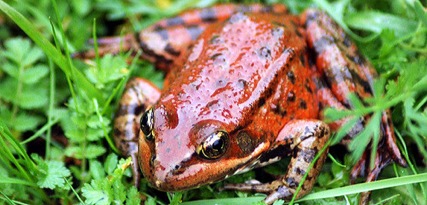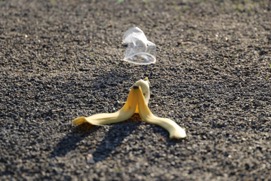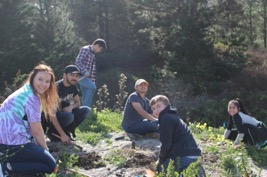|
Dear ,
February drought brings… March flowers? Spring came early this year! We’ve been loving the wildflowers popping up in our parks and we hope you have too.
The planting season is almost over, and we are proud to announce we’ve collectively put almost 8,000 plants in the ground this year! As always, none of this work would be possible without our trusty volunteers, so we’re sending out a big kudos to all of you. Let’s hope March brings just as much good work and maybe a little more rain.
In This Newsletter:

A Day in the Life of a California Red-Legged Frog (From the Frog’s Perspective)
By Rosie Frederick
6 am
The sun breaks clear over the saw-toothed edge of the tule reeds and cattails. From down here, the angle of the early light on the surface of my pond is almost blinding. In between the sunspots, I spy a skipper dancing its way around a clump of algae. Perfect—breakfast has arrived.
With a muted plop, I leave the safety of my rushes and enter the water, kicking silently towards my prey. I emerge quietly, eyes poking above the surface of the water, steeling myself for the right moment….
A-ha: an opening! Time to strike!
.
.
.
Another failure. Invertebrates these days are getting wilier by the minute!
I slink back to my cattails in shame. It’s a frog-eat-frog world out there, and an amphibian who can’t catch insects is bound for defeat. I nestle further into the reeds, contemplating my own mortality and waiting for the morning sun to start warming the bank. At the very least, I can catch some rays while I wait for less shrewd prey.
Noon
High noon, and my pond is glistening like one of those candy wrappers people throw over the boardwalk into my wetland. I survey the scene: a group of flies perusing some algae in the shallows, a chorus frog chirping away by the bank, and a red-winged blackbird, observing the goings-on from a tule stalk with an air of haughty disdain.
I’ve installed myself on a secluded log, sunning myself and contemplating my options. I am a young frog, new to this wild life and unsure in my path. Perhaps I’ve been too timid in my hunt—the wary skippers and flies present a small reward for my efforts. Perhaps larger prey is on my horizon. I turn to the chorus frog.
Go big or go home, my mama always said. Or I imagine her always saying. I never met her, but I assume she’d be the sort of frog to produce such aphorisms.
My path clear, I hop toward the frog with renewed vigor. I settle in some rushes nearby the unsuspecting creature, patiently lying in wait. My prey hops closer, inspecting a nearby puddle. I hold my position—not yet… not until I see the gold of his eyes….
He’s small, a juvenile like myself, and untrained to the dangers of the big pond. He hops once more, spying an interesting leaf to attend to. His mistake.
I strike! Tongue out, sticky-side up. It catches.
Success! I finish the job, swallowing my prey and ensuring my survival for at least another day. I believe a nap is in order for my troubles.
6 pm
The last rays of the setting sun light my pond golden and draw long shadows from the gently waving tule. My dorsal ridges are brushed orange and the pads of my toes begin to chill in the gathering dusk.
I should take up position in my cattails again soon; the night will bring a new host of characters to my watery world. I rest for a moment, contemplating my accomplishments and finding myself satisfied for the first time since I grew legs. Not a bad day.

PC: KQED Science. "Red-Legged Frog."
But it’s Biodegradable Right?
By Camila Fishtahler
You’ve been outside for the past three hours, and then you start to get that sensation of hunger creeping up on you. Obviously it is snack time (the most important time of the day).
You pull out that banana you’ve been saving for this exact moment and once you’ve successfully fulfilled its destiny by demolishing the inside goodness, you’re left with the very unappetizing outer peel.

A Pile of Compost. Photos Credit: Pixabay |
You don’t want your pack to forever smell of bananas so, as many others do when left with the outer layer of the yellow fruit… you chuck the sucker as far as you can throw it.
Now judging from the title of this article I’m going to guess that you are going to guess that I will say something along the lines of “A banana peel does not biodegrade….” But I wouldn’t say that either.
After reviewing some litter-ature I found several definitions for biodegradability, all of which sound roughly like: biodegradability is the ability of an organic substance/material to be broken down by microorganisms, through the action of enzymes, into simple inorganic molecules (think carbon dioxide, water, methane, etc.). 1
But things get complicated when dealing with compostability, because you apparently can’t compost biodegradable plastics. This is mostly because compostable plastics are required to be toxic-free, and have a restricted timetable within which it is expected to totally decompose in a commercial composting facility, whereas biodegradable plastics aren’t restricted to either of those criteria. 2
But in our scenario, we are talking about a banana peel—an organic, purely plant-made substance, right? Not this manufactured, human-made commercial goods nonsense; but organic matter like leaves, dog poop, and tree branches. You know, nature stuff.
The real question should be: Would it be there if you weren’t there? “Pack in, pack out” is one of the core tenets of Leave No Trace principles. Other people also want to enjoy our wildlands, and finding orange or banana peels littered across the landscape isn’t exactly enjoyable and I am guessing you wouldn’t like to see other people’s trash out there either.
Apparently some areas in Scotland had a large enough problem with peels that the phenomenon caught the attention of the UK news organization: The Guardian.3
These things we would consider “appropriate” to throw back into the great outdoors actually take a really long time to break down and may have environmental consequences that we don’t always anticipate (such as influencing the behaviors of animals).
The rate of decomposition comes down to environmental conditions and the chemical makeup of organic matter. Living organisms are made up of thousands of chemical compounds and some are much easier to decompose than others. 4
Has anyone watched the YouTube video of how long food from McDonalds takes to degrade? We like to think that it's because that stuff is some inorganic substance, but really some things don’t degrade because it dries out. Bacteria and fungus (our favorite decomposers) cannot grow on something if there is no moisture.

Litter on the Ground.
Photo Credit: Pixabay Laura Tara |
Same thing happens with orange and banana peels—we’ve taken out the fruit, which primarily provides moisture. Without its center, the peel will dry out and take forever to degrade.
So I’ve obviously been building this up: how long does it take for a banana peel to degrade, then? The answer: around two years, same as the peel of a citrus fruit! Even something like an apple core takes about two to three months. Chewing gum? Its non-biodegradable! 3 6 7
But if that peel was thrown into a compost pile, where those microbes, fungi, and worms are already present, the process of decomposition could be as fast as three weeks. 8
Speaking of Dog Poop...
I’m sure you noticed dog poop is rampant in our local national parks. It’s something our adorable four-legged, easily excitable companions need to rid themselves of from time to time. I’m sure some people believe they are doing a service to the ecosystem, a type of fertilizing, if you will. Litter do they know… they are harming our parks.
A really weird fact I ran across is that dog poop is the third-largest contributor to water pollution in urban watersheds, contaminating water with excess nutrients and pathogens. We would think that their poop would act like cow manure, but due to the high protein diet of our tail-wagging buddies, their waste is actually highly acidic and can damage plants and soil. 10
The feces from man’s best friend can contain fecal coliform bacteria, which is associated with the spread of serious diseases such as giardia, salmonella, MRSA, and campylobacter. 5 9 And according to the CDC: there needs to be extended exposure at 140 degrees F to kill harmful pathogens such as E. coli and salmonella—which most home compost piles aren’t able to reach.
Horse poop is not entirely innocent either; they are also associated with nutrient contamination in waterways. However, in our parks, they aren’t as prevalent as pups, so horses aren’t producing as much waste.
So if you packed it, bag it! I mean littering is trashy anyway right?
Regular Volunteer Information and Work Day Schedules
As always, thank you all for continuing to come out to help restore our national parklands! We couldn’t do any of this without you. Here is the schedule for regular volunteer hours for the month of March. Come hang out and do some restoration!

|
| Volunteers enjoying the sunshine and planting at Mori Point. |
Regular San Mateo Parks Stewardship Drop-In Dates
Saturdays, 10 am–1 pm
Work day events include a combination of hands-on service projects and short natural or cultural history talks. To learn more or sign up, visit our website by clicking here.
March 3 – Rancho Corral de Tierra
March 10 – Mori Point
March 17 – Milagra Ridge
March 24 – Rancho Corral de Tierra
March 31 – Mori Point
Sincerely,
Team San Mateo
Georgia, Rosie, and Camila 
|